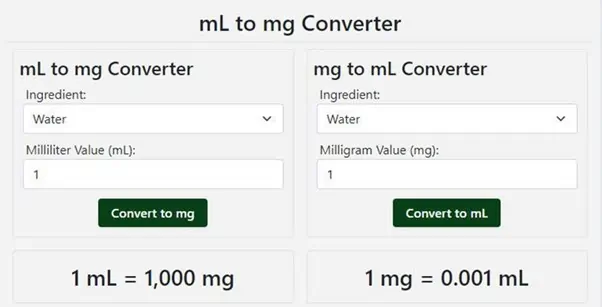In the world of science, medicine, and culinary arts, precision is paramount. Converting between units of measurement is a fundamental skill, especially when dealing with substances like liquids or powders where mass and volume are crucial. One common conversion is from milliliters (ML) to milligrams (MG). While the process may seem daunting at first, it’s relatively straightforward with the right approach. In this comprehensive guide, we’ll explore everything you need to know to master the art of converting milliliters to milligrams.
Understanding the Basics
Before diving into the conversion process, it’s essential to understand the basic concepts of volume and mass. Milliliters (ML) measure volume, representing one-thousandth of a liter, while milligrams (MG) measure mass, equal to one-thousandth of a gram. The relationship between the two depends on the density of the substance being measured. Density is the mass per unit volume of a substance and is typically expressed in grams per milliliter (g/mL).
The Conversion Formula
To convert milliliters to milligrams, you need to consider the density of the substance in question. The formula for this conversion is:
Mass (MG)=Volume (ML)×Density (g/mL)Mass (MG)=Volume (ML)×Density (g/mL)
This formula demonstrates that the mass in milligrams is equal to the volume in milliliters multiplied by the density in grams per milliliter. Once you have the density of the substance, you can use this formula to perform the conversion accurately.
Identifying the Density
The key to a successful conversion lies in accurately determining the density of the substance you’re working with. The density can vary depending on the nature of the material—liquids, solids, or powders—and its temperature and pressure conditions. Common substances like water, milk, oil, and various chemicals have well-known densities that can be easily referenced from scientific databases, textbooks, or online resources.
Using Conversion Tools
Several online tools and calculators can simplify the process of converting milliliters to milligrams. These tools allow you to input the volume in milliliters and the density of the substance to obtain the corresponding mass in milligrams instantly. Websites like mltomg.com offer user-friendly interfaces for performing such conversions accurately.
Step-by-Step Conversion Process
For those who prefer manual calculations or don’t have access to online resources, here’s a step-by-step process to convert milliliters to milligrams:
1. Identify the Volume (ML): Begin by determining the volume of the substance in milliliters. This could be the volume of a liquid in a container, the amount of medication prescribed, or any other quantity specified.
2. Determine the Density (g/mL): Research or look up the density of the substance in grams per milliliter. If the density is not readily available, you may need to measure it experimentally using appropriate equipment.
3. Apply the Conversion Formula: Once you have the volume in milliliters and the density in grams per milliliter, plug these values into the conversion formula:
Mass (MG)=Volume (ML)×Density (g/mL)Mass (MG)=Volume (ML)×Density (g/mL)
4. Perform the Calculation: Multiply the volume in milliliters by the density in grams per milliliter to obtain the mass in milligrams. Ensure that your units are consistent throughout the calculation.
5. Verify and Round: Double-check your calculation to ensure accuracy. Depending on the level of precision required, you may need to round the result to the appropriate number of significant figures.
Practical Examples
Let’s illustrate the conversion process with a couple of practical examples:
Example 1: Converting Water
Suppose you have 150 milliliters of water and want to convert it to milligrams. The density of water at room temperature is approximately 1 gram per milliliter. Using the conversion formula:
Mass (MG)=150 ML×1 g/mL=150 MGMass (MG)=150ML×1g/mL=150MG
So, 150 milliliters of water is equivalent to 150 milligrams.
Example 2: Converting Olive Oil
Imagine you have 250 milliliters of olive oil and need to convert it to milligrams. The density of olive oil is around 0.92 grams per milliliter. Applying the conversion formula:
Mass (MG)=250 ML×0.92 g/mL=230 MGMass (MG)=250ML×0.92g/mL=230MG
Thus, 250 milliliters of olive oil corresponds to 230 milligrams.
Conclusion
Converting milliliters to milligrams is a fundamental skill required in various fields, including science, medicine, and cooking. By understanding the relationship between volume, mass, and density, mastering this conversion becomes manageable. Whether you rely on online tools or perform manual calculations, following the steps outlined in this guide will enable you to convert with confidence and accuracy. With practice, you’ll become proficient in converting between milliliters and milligrams, enhancing your ability to work effectively with different substances and measurements.
